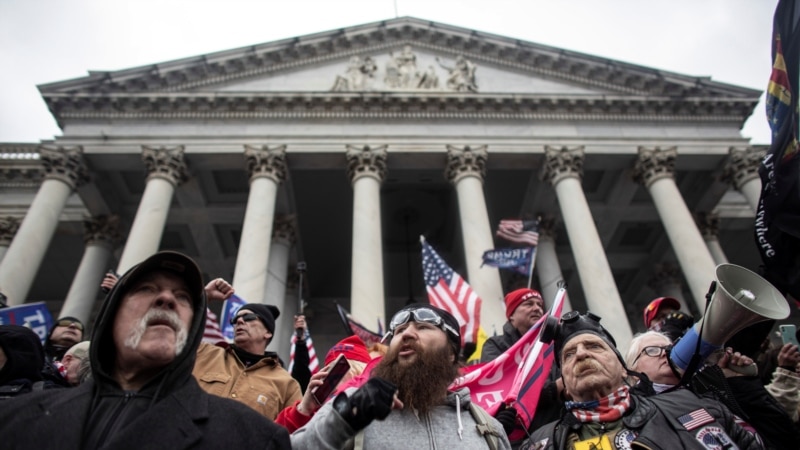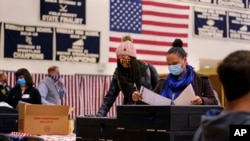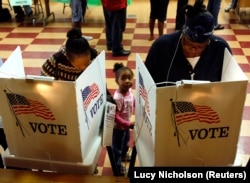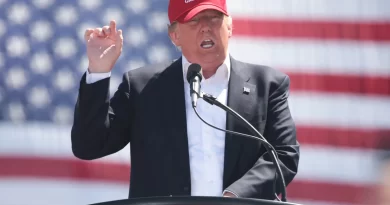Putin Drives Russian Influence Campaign With Rigged 2020 US Election Claim
On January 18, the U.S. State Department announced an initiative to combat efforts by authoritarian governments to undermine democratic institutions.
That initiative seeks to establish a “coordinated international response” to “protect free and open societies” from “information manipulation,” and safeguard elections from foreign interference.
A U.S. intelligence assessment publicized in October 2023 said Russian actors were already spreading and amplifying information “to undermine public confidence in the U.S. 2020 election.”
The assessment noted that “senior Russian government officials, including the Kremlin, see value in this type of influence operation and perceive it to be effective.”
That starts with Russian President Vladimir Putin.
With the 2024 Republican Party presidential primaries underway, Putin has set a tone for the Russian influence campaign to erode faith in U.S. democracy.
During a January 16 meeting in Moscow, Putin falsely claimed the 2020 U.S. presidential election was rigged. He further claimed that sham 2022 referendums Russia claimed to have held in occupied Ukraine were “legitimate.”
Putin’s disinformation narrative focused on invalidating the legitimacy of mail-in ballots.
“No one will force you to come to the polling station,” Putin said describing the “referendums” the Kremlin claims to have organized in occupied Ukraine, with no evidence that the voting took place.
“It’s probably possible to falsify anything. Just like the previous elections in the U.S. were falsified through voting by mail. Well, it’s clear what voting by mail is. They bought ballots for $10, wrote them in, and without any supervision from observers, tossed them into mailboxes.”
That is false.
Putin’s comments grossly distort how mail-in voting works in the U.S.
In response to the COVID-19 pandemic, voting by mail was expanded across the U.S. to mitigate the public health challenges of in-person voting.
Voting by mail has become a politicized issue in the U.S. after former President Donald Trump argued that mail-in voting resulted in fraud and contributed to his losing the election. While not backed by evidence, many of Trump’s Republican colleagues supported his allegations.
Other conservative voices in the U.S. political spectrum also argue that in-person voting has advantages over mail-in voting.
For example, Hans A. von Spakovsky, senior legal fellow at the conservative Heritage Foundation think tank, argues mail-in ballots are the “most susceptible to being stolen, altered, and forged” and can result in people being “pressured or coerced when voting,” as “they are the only type of ballots marked in an unsupervised, unobserved setting.”
Spakovsky also argues that problems at mail-processing facilities result in some ballots not arriving on time.
Despite scrutiny, no evidence was uncovered to prove that mail-in voting during the 2020 U.S. presidential election resulted in widespread voter fraud.
Putin’s claim that people bought ballots for $10 is false. The ballots are free, although issues have arisen over the postage cost.
But 19 states and the District of Columbia cover the cost of mailing in the ballot.
As Putin said, ballots are not observed when they are returned through the postal service or put in secure drop boxes provided by election authorities.
But again, Putin’s conclusions that this resulted in fraud are wrong.
The reason there are not guards at every drop box is because security measures are employed before the ballots are sent to voters and after ballots are collected from drop boxes or received by election officials through the mail.
Steven Bellovin, a security expert at Columbia University in New York, outlined those measures in October 2020.
First, absentee ballots are sent only to registered voters whose place of residence is verified by election officials.
The officials use nested envelopes to mail these ballots, and the inner envelope or attached flap contains verification data, including a signature and serial number or bar code “to provide confidentiality.”
That serial number is matched with each voter’s number in the registry database, “making it impossible for someone to simply print up a pile of blank ballots and submit them,” Bellovin wrote.
The voters’ signatures are also checked to make sure they match what’s in the registration database.
The ballot is only removed from the envelope after those steps are completed, protecting “the confidentiality of mail-in ballots just as with in-person voting.”
Bellovin noted that polling stations often require both Democratic and Republican poll workers to be present whenever completed ballots are handled.
There is evidence that fraud with mail-in voting is more frequent than in-person voting.
However, studies indicate that instances of voter fraud with mail-in ballots are rare. A comprehensive study by News21, a national investigative reporting project, called the number of fraud cases “infinitesimal,” meaning extremely small.
Through an “exhaustive public records search,” News21 identified 491 cases of absentee ballot fraud and 400 cases of registration fraud nationwide from 2000 to 2012.
That timeframe covered a period “in which literally billions of votes (in person and by mail) were cast,” Richard Hasen, an American legal scholar wrote in a Washington Post opinion piece.
Debunking claims of mail-in voting fraud, fact checkers at USA Today compiled several 2020 studies showing “mail-in voting is safe and secure.”
That includes a study conducted by the Washington Post and Electronic Registration Information Center, which found that only 0.0025% of 14.6 million votes cast by mail in the 2016 and 2018 general elections represented cases of potential fraud.
More broadly, voter fraud in the U.S. is rare.
The Brennan Center for Justice, a liberal-leaning nonprofit law and public policy institute, argues it “is more likely that an individual will be struck by lightning than that he will impersonate another voter at the polls.”
In a 2007 study, the center reviewed several elections that had been “meticulously studied for voter fraud” across the U.S. and found rates of fraud between 0.0003 % and 0.0025%.
The center compiled a list of over a dozen other studies, analyses and research, showing “fraud by voters at the polls is vanishingly rare.”
When trashing the U.S. 2020 election and whitewashing the Kremlin’s “referendums” in occupied Ukraine, Putin claimed it is impossible to force people to vote “at gun point.”
But Russian forces did just that, as evidence showed Moscow-installed officials and armed troops going door to door to collect “votes” during the illegal annexation of Ukraine’s occupied regions in September 2022.
Photos also surfaced showing people filling out their ballots with the Russian armed troops standing over them.
Witnesses in territories liberated by Ukrainian forces confirmed that Russian authorities had intimidated the referendum voters.
United Nations Secretary-General Antonio Guterres condemned those referendums, calling them “a violation of the Principles of the U.N. Charter and international law.”
This article has been archived for your research. The original version from Polygraph.info can be found here.





